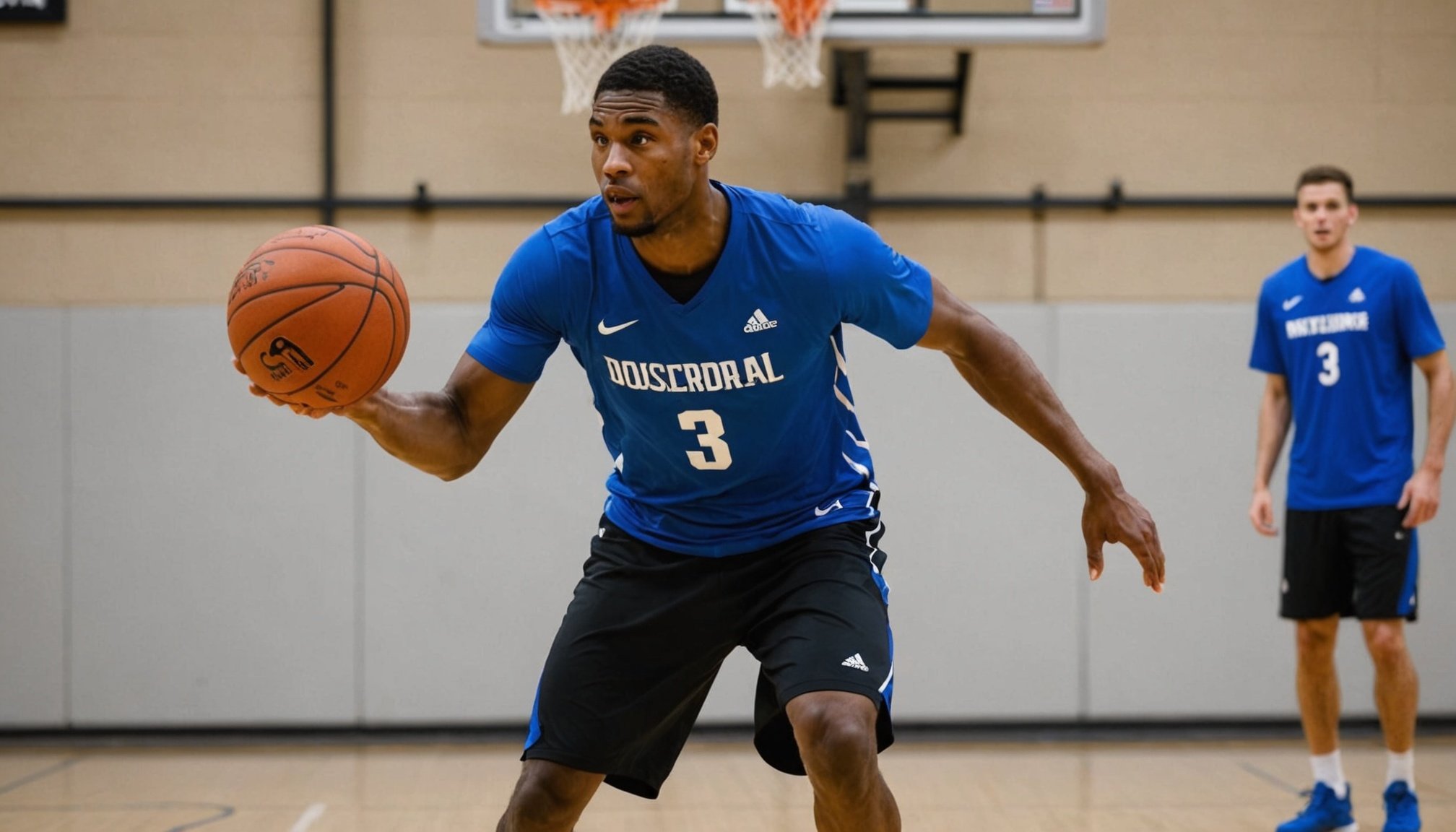Top Agility Drills Every UK Basketball Forward Should Master
Understanding the Importance of Agility in Basketball
Agility is a cornerstone of basketball, particularly for forwards who need to be versatile, quick, and agile to outmaneuver opponents. Agility drills are designed to enhance a player’s speed, change of direction, and overall performance on the court. Here’s why agility training is crucial for UK basketball forwards:
- Speed and Quickness: Agility drills help players improve their speed and quickness, allowing them to rapidly change direction and accelerate. This is essential for chasing down rebounds, defending against faster opponents, and creating scoring opportunities.
- Injury Prevention: By strengthening multiple muscle groups and improving joint stability, agility drills can reduce the risk of injuries. This is particularly important for basketball, a high-impact sport that involves frequent jumps, landings, and sharp turns.
- Neuromuscular Coordination: Agility training enhances the communication between the brain and muscles, improving balance, fine motor control, and overall athletic performance. This coordination is vital for making sharp cuts, jumping for rebounds, and maintaining balance during intense gameplay.
Key Agility Drills for Basketball Forwards
Cone Drills for Speed and Change of Direction
Cone drills are a staple in basketball agility training. Here are some of the most effective drills:
Have you seen this : Essential Warm-Up Routines to Safeguard UK Basketball Players from Hamstring Injuries
-
Zigzag Cone Drill:
-
Set up cones in a zigzag pattern.
Additional reading : Maximizing Game-Day Stamina: Essential Nutrition Strategies for UK Basketball Centers
-
Players sprint through the course, making sharp turns around each cone.
-
This drill improves speed, agility, and the ability to change direction quickly.
-
To add a competitive element, set up parallel lanes and have players race against each other.
-
Straight Line Cone Drill:
-
Place three cones in a straight line, 5-10 meters apart.
-
Players sprint to the first cone, return to the start, and then run to the farthest cone.
-
This drill focuses on speed and rapid direction changes. Adding a timer can increase the challenge.
Ladder Drills for Footwork Precision
Agility ladders or markers set up in a ladder-like pattern are excellent for improving footwork precision.
- Ladder Run Drill:
- Set up the ladder on the ground.
- Players jump or step over each rung, moving their feet quickly and precisely.
- To increase difficulty, widen the distance between the rungs or add a ball-handling element where players dribble while navigating the ladder.
Shuttle Runs and Jump Stops
Shuttle runs and jump stops are essential for improving speed, agility, and strength.
-
Shuttle Run Drill:
-
Set up two lines 10-15 meters apart.
-
Players start at one line, sprint to the other, and then return.
-
This drill can be repeated for multiple sets and reps to build endurance and speed.
-
Jump Stop Drill:
-
Players sprint towards a cone or marker, then jump and land in a defensive stance.
-
This drill simulates the quick stops and changes of direction that occur during a game.
-
It also helps in strengthening the legs and improving balance.
Strength Conditioning to Support Agility
Strength training is a critical component of agility development. Here’s how strength conditioning can support agility drills:
Lower Body Strength
- Squats and Lunges: These exercises strengthen the legs, which are essential for jumping, sprinting, and changing direction quickly.
- Example: Perform 3 sets of 10 reps of squats and lunges, focusing on proper form and explosive power.
Core Strength
- Planks and Russian Twists: A strong core improves stability and balance, which are vital for agility.
- Example: Hold a plank for 30-60 seconds and perform 3 sets of 15 reps of Russian twists.
Upper Body Strength
- Push-ups and Dumbbell Rows: While the lower body is more directly involved in agility, upper body strength helps in overall stability and endurance.
- Example: Perform 3 sets of 10 reps of push-ups and dumbbell rows, focusing on maintaining good form.
Integrating Dribbling Exercises into Agility Drills
Dribbling exercises can be seamlessly integrated into agility drills to enhance ball handling skills while improving speed and agility.
Dribbling Through Cones
- Cone Weave Drill:
- Set up cones in a zigzag or straight line pattern.
- Players weave through the cones while dribbling the ball.
- This drill improves ball control, footwork precision, and the ability to change direction quickly while maintaining possession of the ball.
Figure-Eight Drill
- Figure-Eight Drill:
- Set up two cones about 5 meters apart.
- Players dribble the ball in a figure-eight pattern around the cones.
- This drill enhances ball handling skills and agility, particularly in tight spaces.
Team-Based Agility Drills
Team-based drills are essential for improving communication, coordination, and overall team performance.
Small Court Games
- 3-on-3 or 4-on-4 Games:
- Set up a small court using cones or markers.
- Divide players into teams and have them play a game within the confined space.
- This drill forces players to work together, communicate effectively, and make quick decisions under pressure.
Passing and Coordination Drills
- Square Passing Drill:
- Set up cones in a square pattern with players positioned at each corner.
- Players pass the ball to each other and immediately move to a different cone.
- This drill reinforces communication, teamwork, and the ability to control the ball while moving quickly.
Practical Insights and Actionable Advice
Here are some practical tips and advice for incorporating these drills into your training regimen:
Create a Balanced Training Schedule
- Example:
- Allocate 2-3 days per week for agility training.
- Include strength conditioning exercises 2-3 times a week.
- Ensure adequate rest and recovery time to avoid injury.
Use Timers and Competitions
- Example:
- Use timers to track progress and increase the challenge.
- Set up competitions among players to enhance motivation and performance.
Focus on Proper Form and Technique
- Example:
- Ensure players maintain proper form during strength training and agility drills.
- Correct any technique issues promptly to prevent injuries.
Table: Comparing Key Agility Drills
| Drill Name | Description | Benefits |
|---|---|---|
| Zigzag Cone Drill | Sprint through a zigzag course of cones | Improves speed, agility, and change of direction |
| Straight Line Cone Drill | Sprint to and from cones in a straight line | Enhances speed and rapid direction changes |
| Ladder Run Drill | Jump or step over rungs in an agility ladder | Improves footwork precision and speed |
| Shuttle Run Drill | Sprint between two lines, repeating for sets and reps | Builds endurance and speed |
| Jump Stop Drill | Sprint, jump, and land in a defensive stance | Strengthens legs and improves balance |
| Cone Weave Drill | Dribble through a course of cones | Enhances ball control, footwork precision, and agility |
| Figure-Eight Drill | Dribble in a figure-eight pattern around cones | Improves ball handling skills and agility in tight spaces |
| Small Court Games | Play 3-on-3 or 4-on-4 games in a confined space | Improves communication, coordination, and team performance |
| Square Passing Drill | Pass the ball and move to different cones in a square pattern | Reinforces communication, teamwork, and ball control |
Quotes from Coaches and Players
- “Agility training is not just about running through cones; it’s about developing the ability to change direction quickly and maintain speed. This is what sets top players apart.” – Coach Tony, X-Factor Speed Drills.
- “Incorporating strength conditioning into our agility training has significantly improved our team’s performance. It’s not just about being fast; it’s about being strong and stable.” – John Calipari, Kentucky Wildcats Coach.
Mastering agility drills is essential for UK basketball forwards looking to enhance their performance on the court. By incorporating a variety of cone drills, ladder drills, shuttle runs, and team-based exercises into their training regimen, players can improve their speed, agility, and overall sports performance. Remember to balance training with strength conditioning, focus on proper form and technique, and use timers and competitions to keep the training engaging and challenging. With consistent practice and dedication, basketball forwards can achieve the agility and quickness needed to excel in this demanding sport.











